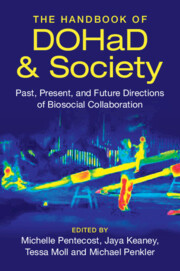The title of this book – The Handbook of DOHaD and Society – suggests the need for a greater integration between two broad fields: one an area of biomedicine and the other in social studies. But linking them also indicates a synthesis of these areas. The nature of a handbook is to provide a go-to source of information on a particular subject or, in this case, on convergent fields. It should give a guide to underlying concepts and current methodologies and offer insights into new ideas and research possibilities. It is therefore far more ambitious than a multi-author book comprising disparate chapters, perhaps resulting from a symposium where diverse topics were presented but not synthesised. As past and current presidents of the International DOHaD Society and researchers and advocates for Developmental Origins of Health and Disease (DOHaD) who have worked with colleagues in the social sciences for some time, we believe that this volume does indeed meet the expectations raised by its title. The chapters have been carefully considered and commissioned by thought leaders in their subject areas, and they have been written to avoid unnecessary overlap whilst demonstrating linkages. The authors have shared drafts and engaged in discussions, and all chapters have been reviewed by the editors and others and modified appropriately. It has been a huge task, and we congratulate the editors on their achievement.
Why is this handbook so timely? When the term DOHaD was developed to supersede Fetal Origins of Adult Disease (FOAD) two decades ago, it was seen as a burgeoning field that would need to encompass the social as well as the biomedical sciences. This was because ‘development’ was clearly a broad term that described life from conception to maturity and the environments in which it takes place, as opposed to the phase of mammalian life in utero. It recognised the importance of a range of comparative studies and insights from developmental biology and evolutionary biology. Moreover, by extending consideration to include health as well as disease and considering health and disease across the lifecourse rather than just in adulthood, DOHaD recognised the importance of much broader contexts. This included integrating growing understandings of developmental plasticity as well as what are now termed the social determinants of health. Of course, this broader conceptualisation of development in itself was far from new; Hippocrates, for instance, expounded on the connection between public health and the environment and indeed the importance of the early environment for the development of the individual. Nonetheless, as social science studies of DOHaD have shown, the concept of environment tends to be overly simplified in DOHaD research, a tension grappled with across many of this handbook’s chapters.
DOHaD had to confront a growing imbalance in biomedical sciences that privileged the reductionism of genetics, which dominated the last decades of the twentieth century and led to the claims that the Human Genome Project would reveal the primary causes of common traits and diseases. Against this background, the drivers of global health issues were becoming clear, with particular emphasis on inequalities and social justice between high- and low-income countries, and the formulation of the Millennium Development Goals led to a renewed focus on maternal and child health. It was during this period that the global importance of non-communicable diseases (NCDs) was, belatedly, recognised, alongside the realisation that NCD risk at the population level was not substantially attributable to fixed genetic factors. By late 2011, global bodies such as the United Nations and the World Health Organization (WHO) had recognised the importance of wider environmental influences acting on human development to increase NCD risk. Laboratory sciences had moved on from genetics to epigenetics to account for such processes. By 2015, when the Sustainable Development Goals (SDGs) were announced, DOHaD researchers were actively engaged with colleagues in many other disciplines, especially in the social sciences. At around the halfway mark for the SDGs, it is appropriate to take stock of these collaborations and stress the need to expand them. This handbook is the resource essential to this endeavour.
The handbook illustrates the benefits and new insights gained from interdisciplinarity, but also its challenges. As with other truly interdisciplinary explorations, what might be seen as ‘biosocial DOHaD’ does more than cross disciplines to benefit from different perspectives whilst leaving the field of exploration the same. Rather, it integrates the disciplines, recognising the value and understanding of the concepts, methodologies, and working practices of each discipline. This is easily said but hard to undertake. It requires a deep understanding of the epistemology of the contributing disciplines, going beyond just the language used (although misunderstandings here often create barriers to interdisciplinarity in themselves), and a respect for the insights that very different academic traditions might bring. As with all sciences, the evidence base for both biomedical and social sciences changes, being at best only provisional: studies once seen as the ‘gold standard’ are no longer as pivotal or relevant today. Thus, an understanding of disciplinary histories is also critical to interdisciplinary conversations. The handbook demonstrates the value of such informed interdisciplinary interactions, and it gestures towards future opportunities for collaboratively exploring human development and the impact of early life factors on later life and indeed across generations.



